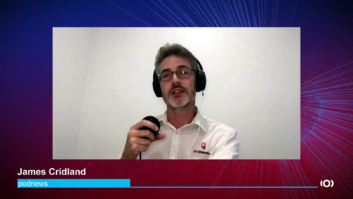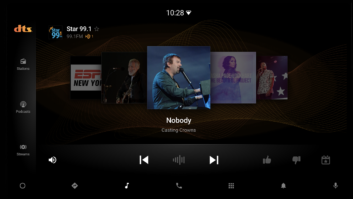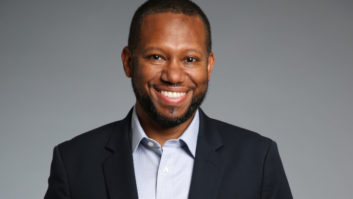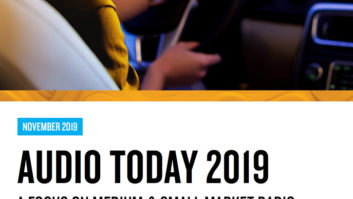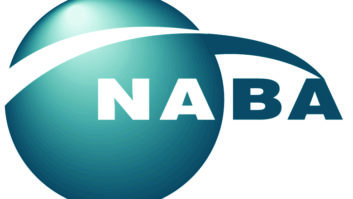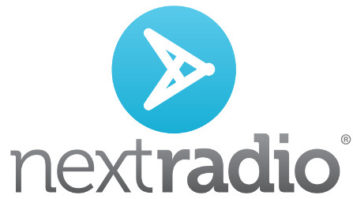
NAB EVP/CTO Kevin Gage: “We need to offer consumers what they want, where they want it, when they want it. Being flexible will keep us moving forward.” Photo by Jim Peck
A wrapup of news from the recent NAB Show. Some information was reported earlier in a different format.
New and improved ways for consumers to enjoy broadcast content are emerging. Longtime standards are being rewritten. And the pace of technological development is accelerating.
The key to remaining relevant and adapting to changing consumer needs is flexibility, says NAB Executive Vice President/Chief Technology Officer Kevin Gage. “Consumers are a long way from abandoning traditional broadcast media. They just want their content anytime, anywhere and on any device.”
He challenges broadcasters to be flexible and nimble in order to keep up. Technology teams need to be prepared, fast to market, agile in development and constant in deployment, he says; and standard-setting times are being compressed in the consumer electronics world, which affects broadcast.
In radio, owners and engineers are watching competitors in the dash increase dramatically and are creating content and delivery systems so that consumers can receive radio on multiple delivery platforms and devices. They seek help from regulators in some cases to help ease the way, such as urging the FCC to relax rules concerning AM station infrastructure to allow those stations to better compete.
Here are some of the major themes concerning radio and its future coming out of the recent NAB Show. Look for more convention coverage next issue as well.
SOONER BETTER THAN LATER FOR AM RELIEF
The FCC is reviewing approximately 165 initial public comments and 55 replies to its AM revitalization initiative.
An idea for which there appears to be overwhelming support is a filing window in which AM owners alone could apply for FM translators, one per AM licensee.
FCC Commissioner Ajit Pai would like to see such a window “no later than 2015.” Bryan Broadcasting Vice President/General Manager and NAB Radio Board member Ben Downs urged FCC Audio Division Bureau Chief Peter Doyle to act quickly on the concept: “Peter, hurry.”
Doyle says the commission is reviewing comments on revitalization “to make sense of what direction we want to go in.” The proceeding is in two parts, Doyle said. The first involves the simplest possible changes, like a translator application window; the second would require additional rulemaking.
Media Bureau Chief Bill Lake characterized radio’s health as a bipartisan concern. He said the commission hopes to bring out a report and order on AM “very soon.”
The opportunity to license an FM translator wouldn’t work for every AM owner. Downs predicts that skywave protection will be controversial, saying Class As will want to protect that listening, while stations that have to sign off early or reduce power during afternoon drive to protect the Class A skywave will not.
In the longer term, Pai said, AM has “difficult issues” to be decided. But the commissioner believes the radio industry’s future looks bright in general. “Radio has an important role to play in the national culture going forward.”
Commissioner Mignon Clyburn said that, growing up, she wanted to be a radio personality, jokingly calling her comment a message “for anybody out there, when my term expires.” More seriously, she said that the commission cares “about all platforms,” noting the AM revitalization initiative was circulated when she was interim agency chair.
EAS CYBER SECURITY IS A PRIORITY

Greg Cooke of the FCC, Antwane Johnson of FEMA IPAWS and Ari Meltzer of Wiley Rein discuss EAS. Photo by Mary Ellen Dawley It’s been more than two years since broadcasters participated in the first national test of the emergency alerting system. Now the FCC is working on a Notice of Proposed Rulemaking to propose changes to its rules based on those results.
So says retired Rear Admiral David Simpson, chief of the FCC’s Public Safety and Homeland Security Bureau. This will lay the groundwork for future regular testing, he says.
Greg Cooke, associate chief of the Policy Division of the bureau, thinks the NPRM will come out “fairly soon — hopefully within the next quarter.”
Simpson says EAS has come a long way; but with its additional functionality comes risk. Last year’s fake so-called “zombie attack,” in which someone gained access to the EAS encoders/decoders of a few stations connected to the Internet, made it clear that EAS needs a secure cyber environment, he believes.
“Pirate attacks can take down your networks and facilities,” says Simpson. He said it’s not a question of if, but when. “We don’t believe the government can set up a moat around broadcasters. You wouldn’t want that anyway.”
A subgroup of the Communications Security, Reliability and Interoperability Council hopes to adopt recommendations in June to protect stations from such attacks. CSRIC advises the FCC on security and public safety issues.
Meanwhile, work to strengthen the station backbone of emergency alerting continues. States had asked FEMA for more Primary Entry Point stations, so FEMA added 38 more, as Radio World has reported.
Antwane Johnson, division director of FEMA’s Integrated Public Alert and Warning System, says the infrastructure work to add those 38 as new Primary Entry Point stations is now complete, for a total of 77 PEPs. He tells RW that FEMA is now focused on upgrading the equipment in the oldest facilities. All have backup generators and fuel systems to enable them to run independent of a station’s power source for about 60 days.
Johnson proposes that the EAS community discuss “everything” related to emergency alerting, including the direction for EAS in the next 10 years; he’d like to have that discussion at the fall Radio Show.
EAS: DON’T “CRY WOLF”
The FCC is serious about its prohibition against simulated or real EAS tones on the air except during emergencies and tests. The agency recently proposed a total of $1.9 million in fines against three companies for airing spots that included EAS warning tones. It says more fines for comparable violations are coming as the agency works through similar cases in its pipeline.
“It’s crying wolf,” says Eloise Gore, associate chief of the FCC’s Enforcement Bureau, about the practice of emulating alerts in advertising. “If you have people become inured to hearing this tone, when there is a real emergency, then they won’t pay attention to a real event.”
The FCC began receiving lots of consumer complaints about this issue about a year and a half ago, she says. She described the problem as a multiplatform one that affects radio and television, cable and satellite systems.
“I had consumer complaints from people who jumped out of the bathtub” when they heard the EAS tones, “because they live in tornado areas,” Gore says. “We don’t want to hear any more of this.”
Companies that were fined did have screening procedures, said Wiley Rein associate Ari Meltzer, but those safeguards applied only to content, not simulated EAS tones. The companies will rework their guidelines to screen for false tones, he said.
ROSENWORCEL LIKES FM CHIP CONCEPT

Commissioner Jessica Rosenworcel supports activating FM chip in cellphones. Photo ©NAB At least one FCC commissioner, Jessica Rosenworcel, supports the concept of enabling FM chips on smartphones, though she didn’t call for a mandate.
NAB Chief Operating and Strategy Officer Chris Ornelas says that in ongoing talks with broadcasters, wireless carriers typically argue that enabling the chip shortens battery life and that handsets lack room for an antenna.
Commissioner Rosenworcel says, “I don’t think you’ll see a mandate. But we’re also not just regulators, we’re consumers. I think it would be really neat to have [an FM chip] on my phone, and I think it would drain my battery a little less.” Noting that one carrier, Sprint, has enabled FM chips on some of its smartphones, Rosenworcel said she hopes that she and her colleagues “will agitate carriers a little to make that happen.”
Sprint has enabled FM chips on at least 11 models and pledged to activate more.
Separately, NAB President/CEO Gordon Smith asked FCC Chairman Tom Wheeler if his commission will have any sway with carriers on the chip issue, especially given Wheeler’s background as former head of the Cellular Telecommunications and Internet Association.
Wheeler didn’t commit one way or the other: “One of the challenges of this job is realities that existed last week won’t exist next week. So we are in the middle of trying to come to grips with how you handle the IP transition in the wired world and wireless world.”
Smith said that when cell towers lose power during a disaster, radio is a secure source of emergency information to consumers. Wheeler acknowledged, “we ought to be having that debate [about] safety in the 21st century. We’ve got to look at the broad aspects” of the chip issue.
MEDIA OWNERSHIP SPLITS COMMISSIONERS
The FCC intends to keep its current local radio ownership limits, saying they help promote localism and open doors for women and minority owners. The limits vary, with up to eight stations allowed in the largest markets.
The agency is asking for public comment on its tentative conclusion, as well as on costs and benefits of retaining the current tiered limits.
The text of a Notice of Proposed Rulemaking released in April puts in writing much of what became apparent in March. That’s when the commissioners voted 3–2 to begin the quadrennial review of media ownership rules.
Some changes do appear to be pending; the commission tentatively found no reason to keep the radio-newspaper cross-ownership ban, and it also proposes eliminating the ban on radio-TV cross-ownership.
Comments to MB Dockets 14-50 and 09-182 are due 45 days after Federal Register publication.
The two Republican commissioners are not happy that the chairman is rolling the pending 2010 media ownership review into the 2014 review, and that action is not expected until 2016.
GOP Commissioner Michael O’Rielly remembers when the review was biennial and the FCC asked to make it every four years. “The promise that we will get to it in 2016 is not comforting,” he says. “The media landscape has changed significantly, but that’s not reflected in our rules.”
Commissioner Ajit Pai said, “We just kicked the can down the road for a couple of years,” though he agrees with the plan to drop the radio cross-ownership rule.
Commissioner Mignon Clyburn, a Democrat, defended the chairman’s timing decision. The agency’s media ownership data is 10 to 15 years old, she said, and the FCC needs to know what the current “ecosystem” looks like as well as the effects new rules might have.
“There does not seem to be a path to get new data that I would be comfortable with. That’s a core reason as to why I’m taking a more deliberative approach,” said Clyburn.
“NEW” GENERATION OPERATES IN REAL TIME he “new” generation of consumers operates in real time, according to tech columnist David Pogue; this has implications for broadcasters. Photo ©NAB

The “new” generation of consumers operates in real time; they have on-demand TV, newspapers and books, and they expect everything “immediately,” says Yahoo tech columnist David Pogue.
The writer, who’s also host of “Nova ScienceNow,” said at the show that a smartphone is so much more than a phone now, and young people often don’t bother to leave, or listen to, voicemails.
“We’re a person-to-person economy,” says Pogue. The Internet plays the role of a giant matchmaker, a trend that started with eBay, which helps strangers “buy and sell junk” without meeting, he said.
Pogue hears frequently that Spotify is going to “kill radio,” but “that’s not how things work,” he said. Instant coffee didn’t kill brewed coffee, nor did DVDs and the VCR make movies obsolete. “Things splinter,” he continued; and new technology also can frighten people.
However, he praised streaming audio services like Spotify and Pandora for enabling users to make playlists and share content. There’s not enough of that in terrestrial radio, Pogue said.
He singled out the NextRadio FM app, calling it “everything radio should be. You should be on the mountain talking about this app!” He noted that the app doesn’t use a phone’s data plan and promises to consume less battery life than does Pandora or Spotify.
Read more about NextRadio in our next issue.
The National Radio Systems Committee approved several updates to its RDS usage guidelines.
Chairman of the RBDS Subcommittee Dan Mansergh, who is director of radio engineering and media technology at KQED Public Media in San Francisco, tells Radio World the biggest change was incorporating guidelines for how to use RDS for emergency alerting.
Previous language addressing emergency alerting and RDS was almost a placeholder, lacking a lot of detail, Mansergh said. “Recent activity with the NPR Labs project in the Gulf states shows how an end-to-end data-driven alerting system complements EAS and the other alerting systems out there through IPAWS.”
He identified GSS, which makes the Alert FM system, as another “significant” contributor. Noting that the GSS system has been deployed for a while, Mansergh said, “Since we were recognizing that there are a number of different ways to use RDS for a variety of applications, it’s useful to explain how the different systems work.”
Stations employ RDS for revenue-generating uses such as traffic data and iTunes Tagging. RDS offers flexible sequencing and rotation options, supporters say.
NRSC UPDATES RDS GUIDELINES

The National Radio Systems Committee, shown prior to the 2014 meeting, is always seeking more members. Sponsored by the National Association of Broadcasters and the Consumer Electronics Association, its purpose is to study and make recommendations for technical standards that relate to radio broadcasting and reception of radio broadcast signals. Photo by Jim Peck
Milford Smith, NRSC chairman and Greater Media’s vice president of radio engineering, says, “This guideline explains how to implement any service that uses RDS.”
The guidelines also clarify specific information about injection levels, especially in regards to compatibility with FM subcarriers.
Mansergh said, “We’ll be looking at that more. We see stations have a desire to have more RDS services. With higher injection levels comes the possibility of interference, which could result in data errors.” The guidelines help stations avoid those.
Mansergh and Smith describe the overall guidelines as a practical, nuts-and-bolts collection of best practices that station engineers can use to implement any service that uses RDS. “It’s something that a radio station engineer can take to the transmitter site and help him or her with the setup,” says Smith. The guidelines are free.
The NRSC last refreshed its RDS usage guidelines about a year and a half ago.
The updated guidelines will be available online (www.nrscstandards.org) once NRSC sponsors NAB and CEA have reviewed the document.
The NRSC is always seeking new members, and Gage specifically invited broadcasters to participate.
ONLINE POLITICAL FILE UPDATE
The FCC reminded television stations that, as of July 1, they are required to post new documents to their online political files. Until now, only stations affiliated with the top four networks in the top 50 markets had to do so.
“The issue is of some importance; this is an election year and by July some campaigns will be well underway,” says Media Bureau Chief Bill Lake.
NAB Executive Vice President and General Counsel Jane Mago anticipates that at some point the FCC will require radio stations to post their political files online as well, but there is no date set for that yet.





